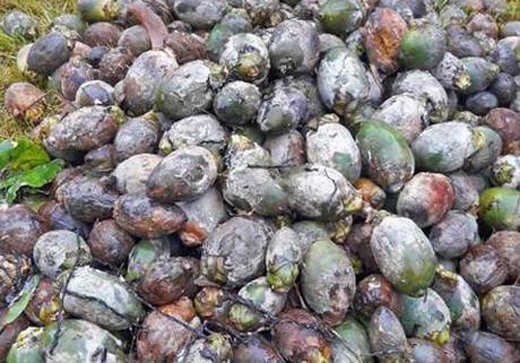
Kole Roga returns to arecanut plantations
Manglore Today News Network
Mangaluru, Sep 09, 2019: With continuous rainfall in the last month, Kole Roga (fruit-rot disease) has returned to the arecanut plantations in Dakshina Kannada, though not in an alarming manner.

If farmers feared that the disease would aggravate if it rained without a break for another week, the Department of Horticulture said that there is no cause for worry.
Ramesh Kaintaje, an agriculturist in Kedila near Mani, said that the disease, characterised by rotting and heavy shedding of immature nuts, has hit the same plantations which were affected by it during the last monsoon.
“I collected two bags of immature nuts from my plantation on Sunday. Some of the plantations in my village have also been affected,” he told The Hindu. In some plantations, it has spread up to 20 %, he said.
Shankaranarayana Bhat Khandige, vice-president, Central Arecanut and Cocoa Marketing and Processing Cooperative Ltd. (CAMPCO), said that the disease was slowly spreading in the plantations across the district. In some plantations in Sullia taluk, it has spread up to the extent of 30 %.
If it continues to rain for another week, the disease might spread at a faster pace, he said.
Deputy Director, Department of Horticulture, H.R. Nayak, told The Hindu that the disease was now sporadic in the district. Kole Roga commonly prevailed to some extent in many plantations during monsoon. Farmers could spray prophylactic solutions to control the disease during June-July as the monsoon was not widespread and continuous. Hence, it has not aggravated, though there was continuous rainfall since the last month.
The Deputy Director said that as the nuts have grown hard now, the chances of the disease aggravating were few. The disease spread faster when the nuts were still tender.
Nearly 56,000 arecanut farmers in the district had sought compensation from the government for loss of produce due to Kole Roga last year. It had hit the plantations on a vast scale, after five years. According to the Horticulture Department, the disease had hit plantations spread over 33,000 hectares last year. The total compensation to applicants had been estimated at ₹ 60 crore as per the National Disaster Response Fund (NDRF) guidelines. It specified ₹ 18,000 as compensation per hectare.
When it struck a large tract of plantations in 2013, the government had to declare a compensation package of ₹ 30 crore for around 25,000 hectares in the district. During the 2007 monsoon, it affected about 20,000 farmers, for whom the government subsequently declared a compensation of ₹ 4.59 crore.
According to the department, about 40,000 hectares in the district are under arecanut cultivation.